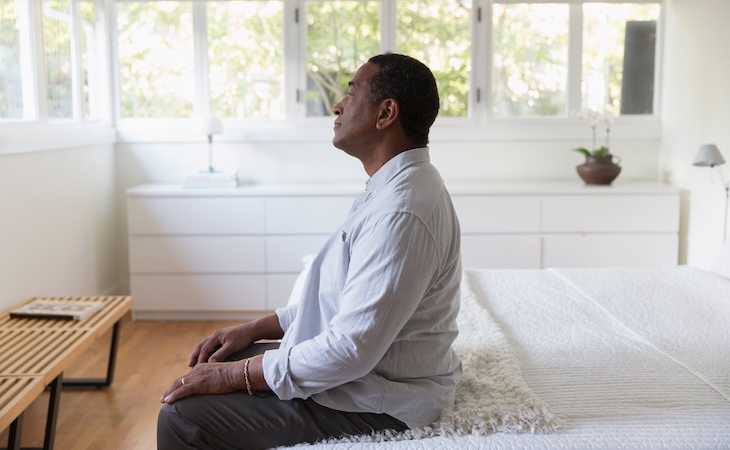You’ve done it! You’ve made the commitment to stick to a steady nighttime routine. And when your new bedtime hits, you’re burrowed under your covers, ready for sleep. The problem? No one told your body. You toss and turn, shuffle around, and basically, try to will yourself into falling asleep. It doesn’t work.
Sound familiar? We all know that sleep is much more complex than we think. But it’s also vitally important, so how can we guide our bodies to a better, deeper sleep
The short answer? Relax. Read through this categorized list of activities that can help relax your body into a smooth and peaceful sleep. After all, the body loves routines, so finding an effective bedtime routine for your body will not only save you hours of tossing and turning, but it will also give you back those critical sleep hours you need for a healthy and rewarding day.
Watch this video about how to put together a relaxing nighttime routine:
Build and maintain your sleep sanctuary
Since we know how important sleep is to our life and well-being, let’s give our sleep space the respect it deserves. Our brain is continuously striving to make associations to the world around us and, by focusing on these three activities, we will help closely connect our brain to our bedroom’s primary purpose: sleep.
1. Declutter
A 2015 sleep study has found that people who sleep in cluttered rooms are more likely to have sleeping problems including trouble falling asleep and rest disturbances. Avoid these sleep threats by keeping your bedroom space orderly, especially the areas close to your bed…meaning it’s probably time to take action again that disheveled stack of books that has lived on your bedside table for the past year!
2. Control the temperature
Our body temperature fluctuates throughout the day. When it’s on the rise, we’re most likely to be alert (think post-workout) and when it’s falling it tells our body it’s time to wind down. To help transition into a deep sleep, it’s recommended to keep the bedroom temperature should be between 60 and 67 degrees Fahrenheit. Make sure it’s not too cold (no shivering) and maybe also try wearing socks to bed. Sleeping with socks on can help dilate your blood vessels and steer your internal thermostat to an ideal setting.
3. Limit non-sleep activities
From our phones, friends, and work, to our favorite Netflix shows, we receive a lot of stimulation during the day. This activity stirs the neurons in our head and according to Mark Rosekind, PhD and former director of the Fatigue Countermeasures Program at the NASA Ames Research Center, it can make us tense and even stimulate the “flight or fight” response in our body. Removing distractions, especially tech, and other activity from our room will help send valuable signals to our bodies that our bedroom is exclusively meant for sleep. It’s better to replace these with calming activities like meditation or take a bath, using Epsom salt for sleep.
Cultivate a sleep state of mind
Even after improving our sleep space, many of our sleep issues can arise in the space between our ears. Stress from work, worry about upcoming events, and angst from the challenges of everyday life, can all add up to a restless night. The following three activities help organize these troublesome areas and aim to open up a more peaceful pathway to dreamland.
4. Create a to-do list
It’s only natural to think about the next day when you’re laying in bed. But the more we think about the demand and responsibilities on the horizon, the easier it is to become overwhelmed. “Anxiety is an emotion that actually wakes us up,” Steve Orma, PsyD, a clinical psychologist and author of Stop Worrying and Go to Sleep: How to Put Insomnia to Bed for Good, tells Huffington Post. If you are finding yourself more anxious than not, try making a To-Do list before you go to bed. This gives you a specific time to organize any thorny issues that could lead to unrest and also helps ensure they won’t pop up again when you’re trying to get to sleep.
5. Practice gratitude
If anxiety is the feeling that keeps you awake, then gratitude is the feeling that helps put you to sleep. A 2011 study with over 400 adults participating backs this up by revealing that gratitude was associated with falling asleep faster and sleeping longer and better. Some tactics you help you practice gratitude include keeping a gratitude journal (hint: start off by recording the best three parts of every day) and engaging in a gratitude discussion with a partner or roommate right before bed.
6. Consider guided imagery
According to the Cleveland Clinic, “Guided imagery is a form of focused relaxation that helps create harmony between the mind and body.” This activity is highly individualized to each person but the general idea is to create a powerful mental scene from a memory, setting, or even vision that produces a sense of calmness. The key is to create something that is rich in detail and pleasantly consumes all your thoughts. The more you practice this activity to more useful it will become as a helpful sleep aid.
Preparing your body for sleep
We’ve got our bedroom and our mind covered, so what are we missing? At the end of the day, it’s our body that puts us to sleep. And while there are a lot of factors at play, here are three areas that directly impact our body and can help guide us closer to our ultimate goal.
7. Practice breathing
The benefits of deep, focused breathing include a reduction in stress and blood pressure, better blood flow, and the release of toxins from the body. Much like our body temperature, our breathing patterns vary throughout the day, becoming more regular and slow as we shift from wakefulness to sleep. So focused breathing has the double benefit of serving as both a trigger and a tool for good sleep. There are numerous exercises you can try to find the one that’s right for you.
8. Observe your light and sound exposure
There is strong evidence that artificial light can negatively affect our sleep. The science also shows that sound can play a role in sleep quality with one study showing that white noise helped reduced awakenings to common intensive care unit sounds. Again, both factors are tied to personal preference, but two general guidelines are making an effort to minimize artificial light (especially blue light from electronics) as you get closer to bed and creating a sound environment that is conducive to sleep.
9. Stretch
While many people think of stretching as a warm-up for athletic activity, it’s also a good warm-up for sleep. Stretching gets the blood flowing to your muscles, can relieve tension in targeted areas, and helps soothe your body before you lay down. A warm bath, especially with Epsom salts, can also help to treat your muscles, relax your body, and move you toward an optimal sleep temperature—if taken far enough in advance (two hours is recommended)—before bed.
Your body knows best
As you can see, there are many areas and activities that go into preparing for a good sleep. But perhaps most important of all, is our final tip:
10. Tailor your routine
Find a combination of bedtime activities that work for you and successfully implement them into your nighttime routine by doing them every night—even on weekends.
Practice makes perfect, so don’t hesitate to get started right away because, if you can achieve this final step, then you will be well on your way to a good night’s sleep.





